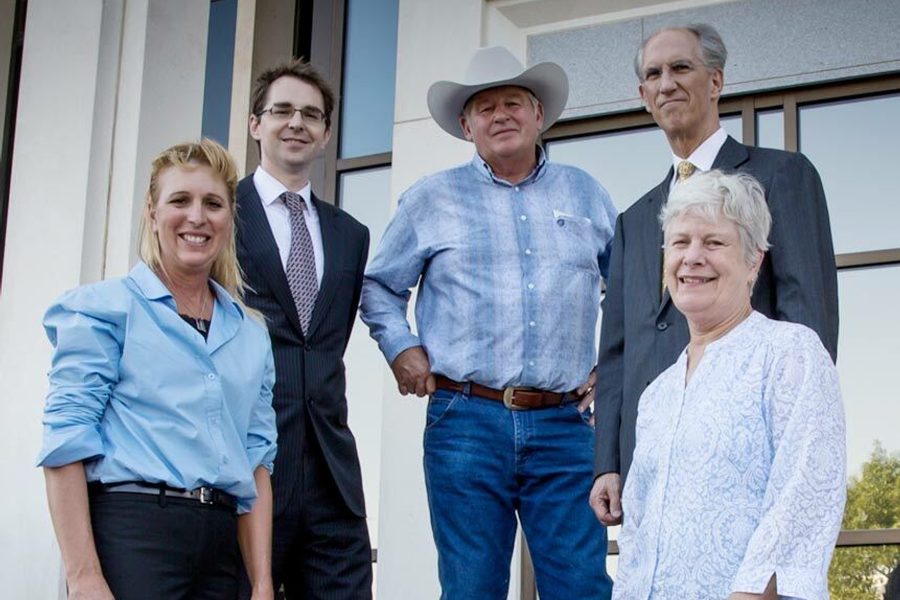Keystone XL Gets Electoral
Green candidates are cropping up all over the ‘red’ state of Nebraska.
Cole Stangler

In the eyes of political consultants and party operatives, environmentalists in the United States are mostly urbanites who sip espresso and oddballs who dabble in other substances. By that logic, America’s heartland — much less a reliably red state like Nebraska — is no place for clean energy advocates.
But a slate of candidates running in the Cornhusker State is hoping to prove conventional wisdom wrong. Driven by the impending Keystone XL pipeline — which would cross about 250 miles of the state — clean energy is on Nebraska’s electoral agenda.
Several candidates for office in 2014 are running campaigns that focus on not only stopping the pipeline, but also putting renewable energy sources, such as wind, front and center. They’ve caught the eye of Bold Nebraska, an environmental group that organizes landowners and ranchers opposed to TransCanada’s efforts to condemn land for the pipeline.
“All of them are what we call ‘new energy candidates’ that are locally grown and powered by the pipeline fighter spirit,” says Jane Kleeb, Bold Nebraska’s director. “We hope this is a clear sign that the fight against the Keystone XL is more than stopping a pipeline. It’s about citizens standing up to be counted, to be engaged and to serve as the next crop of elected officials.”
Among the candidates is the presumptive Democratic nominee for U.S. Senate, Dave Domina, best known for successfully leading the legal fight to overturn a 2012 eminent domain law that paved the way for Keystone’s proposed route. The Nebraska law shifted pipeline-route approval authority from the state regulatory agency to the Republican governor’s office, which then drew up a new course for the project. Domina sued to overturn the law on behalf of concerned landowners last fall. In February, in response to the suit, a county judge ruled the law unconstitutional, throwing a wrench into TransCanada’s plans. (The state’s attorney general has since appealed the decision.)
Domina expects his defense of landowners’ rights and his advocacy for investment in renewable energy to resonate with voters. Nebraska has the fourth-highest wind energy capacity in the nation, but it remains untapped. Much of the state’s energy comes from coal — coal that is produced not in Nebraska, but in Wyoming and Montana, as Domina points out. “I don’t think Nebraskans have any emotional or financial commitment to coal,” he says. “They want clean, cheap energy.”
Domina sees investment in renewables as a commonsense form of job creation that goes hand in hand with his economic vision — a vision that harkens back to the prairie populism of the late 19th century. In that tradition, Domina supports breaking up the five biggest U.S. banks. “It’s the kind of problem we had in the United States 120 years ago when power was way too concentrated in the hands of a few companies and we had to break them up,” he says.
Meanwhile, Chuck Hassebrook, the only Democratic candidate for governor, espouses an environmental platform that would put many of the party’s gubernatorial candidates in other states to shame. As the former director of the Center for Rural Affairs, an anti-poverty group that works to protect family farmers, he calls his home state the “Saudi Arabia of wind” for its renewable energy potential.
Both Domina and Hassebrook face uphill battles. Nebraskans haven’t elected a Democratic senator since 2006, and a Democratic governor since 1994. In both cases it was the conservative-leaning Ben Nelson. The last Democratic presidential candidate to carry the state was Lyndon Johnson in 1964. But Domina isn’t discouraged. He points to the state’s large swath of independent voters as evidence that party affiliation doesn’t matter as much as platform.
The most winnable races, however, are likely at the local level. In Nebraska, these are all non-partisan. Bold Nebraska is working with three candidates for seats on the state’s 23 different Natural Resources District (NRD) boards, local government bodies that deal with water and other conservation issues.
Maggie Squires, a yoga instructor and state senate aide who’s running for a seat on the NRD in Lincoln, the state capital, says she wants to broaden the way these boards approach natural resource management. “[Lincoln is] a huge college town,” she says. “The kids know that clean energy’s the way to go, the future — it’s just that we’re still clinging to this belief that it’s not.”
The group is also working with two candidates for the board of directors of Nebraska Public Power District (NPPD), the state’s largest electrical utility. Critics claim that the 11-member elected board is too friendly with the fossil fuel industry. In August 2013, the NPPD agreed to help finance transmission lines that TransCanada needs for the Keystone XL pipeline. And last October, the board voted against purchasing more wind power.
One of the NPPD candidates is Ben Gotschall, a rancher and cheese maker who grew up in the Sandhills region and helped organize opposition to the Keystone XL. He says it’s critical to get more green voices on the NPPD.
“We could be the national leader in wind energy,” Gotschall says. “We just got huge untapped wind resources and all of our neighboring states are kicking our butts. Our people … wonder why we can’t get on board.”
And it’s not just about the environment, he stresses, but about dollars and cents. Electricity prices in Iowa and Nebraska, both among the lowest in the nation, are roughly the same. In Iowa, though, wind power provides about 27 percent of the state’s electricity generation, compared to a paltry 5 percent for Nebraska, its neighbor to the west. If Nebraska boosted its wind power production, Gotschall argues, then the state’s electricity prices could eventually drop even lower.
Gotschall brushes aside the notion that his Keystone XL-related activism will put him at a disadvantage. “Most of the issues that I’ve been dealing with are very conservative issues: property rights, no eminent domain for private gain,” he says. “But the so-called conservatives haven’t been standing up for that issue here in our state, so the people have had to stand up for themselves. And I think I’m an example of that.”









